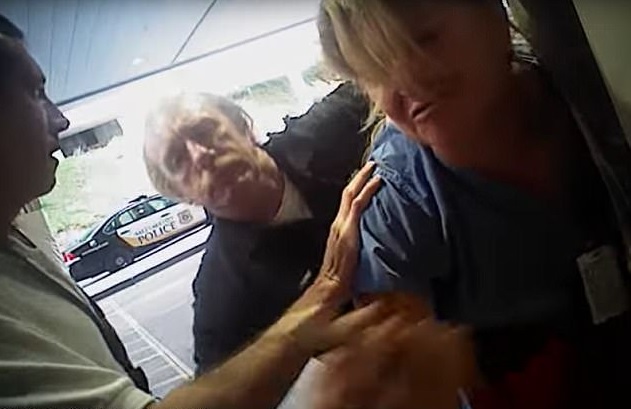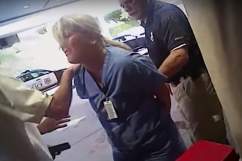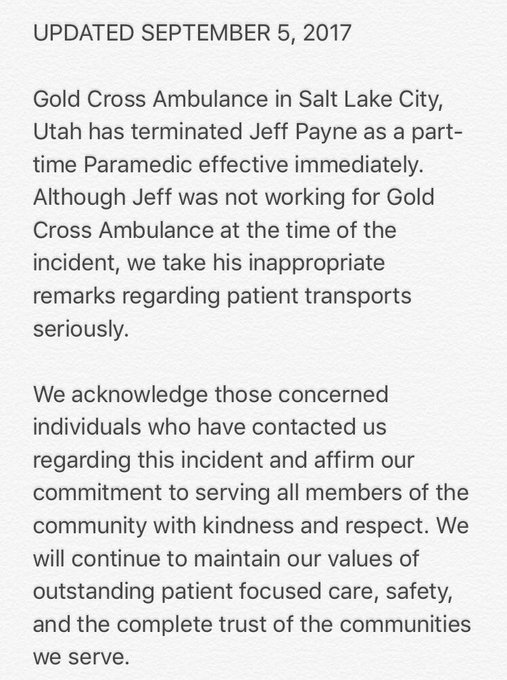
A Salt Lake City Police detective is in hot water for arresting a nurse when she refused to allow blood to be drawn from an unconscious patient.
According to University of Utah Hospital nurse Alex Wubbels, Salt Lake detective Jeff Payne used excessive force when he unlawfully arrested her for her reluctance at drawing blood from a man who was involved in a collision that killed a motorist fleeing police.
The Idaho State Journal reported that 43-year-old William Gray, a reserve police officer in Rigby, Idaho, was severely injured in the ordeal, which took place July 26 at about 2 p.m. Gray, who drives trucks in his spare time, was behind the wheel of a semi truck in northern Utah when a suspect fleeing Utah Highway Patrol officers crashed into him head-on.
The fiery crash can be seen in the dashcam video below:
Gray suffered severe burns from the crash, as he was on fire when he ran out of the vehicle. The suspected driver that fled police, 26-year-old Marcos Torres, died, The Tribune reported.
Hours after the horrific crash, officers with the Salt Lake City Police Department entered the hospital and requested a blood sample from Gray, but were met with reluctance to do so.
In police bodycam video, Wubbels can be heard saying that it’s against hospital policy to draw blood from a patient without consent, a warrant or unless the patient is under arrest.
The video shows Wubbels asking Payne and other officers numerous times if Gray is under arrest. When Payne answers that Gray wasn’t in fact under arrest, Wubbels refuses to allow blood be drawn from him. Payne reiterates that he still has the authority to obtain the blood draw, but Wubbels continues her refusal, saying her job is to “protect her patients.”
Chaos ensues afterward, with Payne threatening to take Wubbels to jail, accusing her of interfering with a criminal investigation. After Wubbels congregated with a number of co-workers and tells Payne that her stance hasn’t changed, the detective informs her she’s now under arrest, grabs her, pulls her arms behind her back and forcibly handcuffs her.
As Payne drags Wubbels outside of the hospital and puts her into his squad car, she can be heard screaming for help, accusing Payne of arresting her for doing nothing wrong.
Here’s what you need to know about Payne and the incident:
1. Payne is Accused of Assaulting Wubbels During the Arrest

Payne is seen in a police bodycam video arresting Wubbels against her will.
Wubbels came forward with parts of the disturbing video while standing alongside her attorney at a press conference. She’s being represented by Salt Lake City attorney Karra Porter and has accused Payne of using excessive force in an “unlawful arrest.”
“The only job I have as a nurse is to keep my patients safe,” Wubbels said. “A blood draw gets thrown around like it’s some simple thing, but blood is your blood. That’s your property.”
Payne has since been suspended from the police department’s blood-draw program, Salt Lake City Police Sergeant Brandon Shearer told The Salt Lake Tribune. The program is intended to train officers as phlebotomist so they can obtain blood samples.
A police report from the incident obtained by The Tribune insinuates that the officers believed they had “implied consent,” but as Porter noted at the press conference, “implied consent” hasn’t been in Utah law since 2007. The United States Supreme Court also ruled in 2016 that the Constitution does permit officers to obtain breath tests without a warrant in drunken-driving cases, but not blood draws.
No claim or lawsuit has been filed yet by Wubbels or Porter, she said.
Watch the video of the arrest by clicking below.
After the video went viral, officials from the hospital spoke out on behalf of Wubbels. Gordon Crabtree, the interim chief executive of the hospital said during a September 5 news conference that he was “deeply troubled” by the incident.”
“This will not happen again,” Crabtree said at the press conference.
According to The Washington Post, chief nursing officer Margaret Pearce said the hospital is implementing changes in its protocol.
Pearce told the newspaper that police are no longer allowed in patient-care areas like the burn unit where Wubbels was stationed. She added that officers now must deal with a “house supervisor” instead of nurses whenever they have a request.
2. The Police Department Said It’s Opened an Internal Investigation & Has Placed Payne on Paid Leave

Detective Jeff Payne subdues nurse Alex Wubbels.
Wubbels was detained for about 20 minutes, she said, before being released. She’s not charged in the incident.
After the detainment of Wubbels and the backlash that resulted from it, Shearer said the department has opened an internal investigation into the incident. One day after the video was released, on September 1, Payne was placed on paid leave, The Associated Press reported.
“This cop bullied me, he bullied me to the utmost extreme,” Wubbels said to the AP regarding Payne.
According to a written report obtained by The Tribune, Payne said he was responding from a request from the Logan Police Department — where Gray’s crash occurred — to obtain the blood sample and find out if he had illegal substances in his system when the incident occurred.
In his report, Payne wrote that Wubbels’ “policies won’t allow (him) to obtain the blood sample without a warrant.” He wrote that he was advised by his lieutenant, James Tracy, to arrest Wubbels for interfering in the investigation if she continued her refusal.
Excerpts of Payne’s bodycam were released by Salt Lake City police, and have been posted online by The Salt Lake City Tribune. In the video clips, you can hear Payne react to the incident with other officers, trying to explain how Wubbels “obstructed” the investigation.
At one point, the voice from another officer appears to be hatching a plan to go up to the burn unit and visit Gray in his hospital bed to try and get the blood sample.
“I don’t have a problem with going and drawing the blood,” Payne said. “I know anywhere I go right now in this hospital, I’m going to get a lot of resistance from anybody and everybody but you.”
3. ‘Use of Force’ Arrests Have Skyrocketed in Salt Lake City, Data Shows

Highcharts.com/Salt Lake City Police DepartmentA screenshot of the ‘Use of Force’ data listed on the Salt Lake City Police Department’s website.
The Salt Lake City Police Department has data on its website that tracks “use of force” arrests within a range, and it shows that complaints skyrocketed at the end of 2016.
The data, listed on the department’s website and compiled by HighCharts.com, shows a record high of complaints at the end of last year.
In May 2016, there were 86 complaints filed to the department about their use of force. That number went up to 89 complaints in June but fell to 70 in July. It reached a high in August with 94 complaints filed and decreased the rest of the year until December, when it received 123 complaints for officers’ use of force during arrests, a high in 2016.
The data are also broken down into the subject of resistance, of which 78.9 percent came from applying handcuffs. Another 6.3 percent came from “defensive resistance.”
Police investigations found that in about 75 percent of those incidents, the use of force was used “to effect arrest,” as seen in the chart below.

HData provided by the Salt Lake City Police Department on ‘Use of Force’ arrests.
The data listed on the website doesn’t yet include use of force arrests in 2017.
4. Payne Received an Award in 2014 from the Police Department
In 2014, Police Chief Chris Burbank hosted the 34th annual Salt Lake City Police Gala, a ceremony where officers were honored for their role on the force throughout the past year.
Payne received recognition for the part he played in the department’s Property Crimes Unit.
The department merged its Larceny and Burglary department into the single Property Crimes Unit in 2012, which, according to the department’s website, allowed for officers to “more evenly distribute cases to detectives.”
According to the department, from June 2013 until January 2014, the Property Crimes unit handled over 16,000 complaints and 12,854 cases were opened as a result.
Payne and his co-workers received recognition from Burbank for the work they put forth in the unit that led to arrests.
“For outstanding dedication to a reorganization that has improved the investigative process, the Salt Lake City Police Department awards the Police Meritorious Unit Citation to Property Crimes,” Burbank read at the ceremony.
5. Payne Has Been Fired From the Ambulance Company He Worked at When off Duty
Later in Payne’s bodycam video, he can be heard speaking to other officers about how the incident could potentially affect his off-duty job at Gold Cross Ambulance.
“I wonder how this will affect my Gold Cross job,” Payne says. “I bring patients here.”
Another officer replies, “Yeah, I don’t think they’re going to be very happy with it.”
Payne responds: “I’ll bring them all the transients and take good patients elsewhere.”
On September 5, Gold Cross Ambulance released a statement saying it has terminated Payne as a part-time paramedic.
“Although Jeff was not working for Gold Cross Ambulance at the time of the incident, we take his inappropriate remarks regarding patient transports seriously,” the company said in its statement.
According to his LinkedIn Profile, Payne attended Weber State University in Ogden, Utah. His profile says he studied to be a paramedic and work in emergency medicine while working toward his associates degree.
Weber State’s Emergency Cary and Rescue Department offers students certifications and associate degrees in emergency medicine. In order to be considered an Emergency Medical Technician-Basic, students must take a one semester, six-credit course that includes taking the National Registry Paramedic Test.



